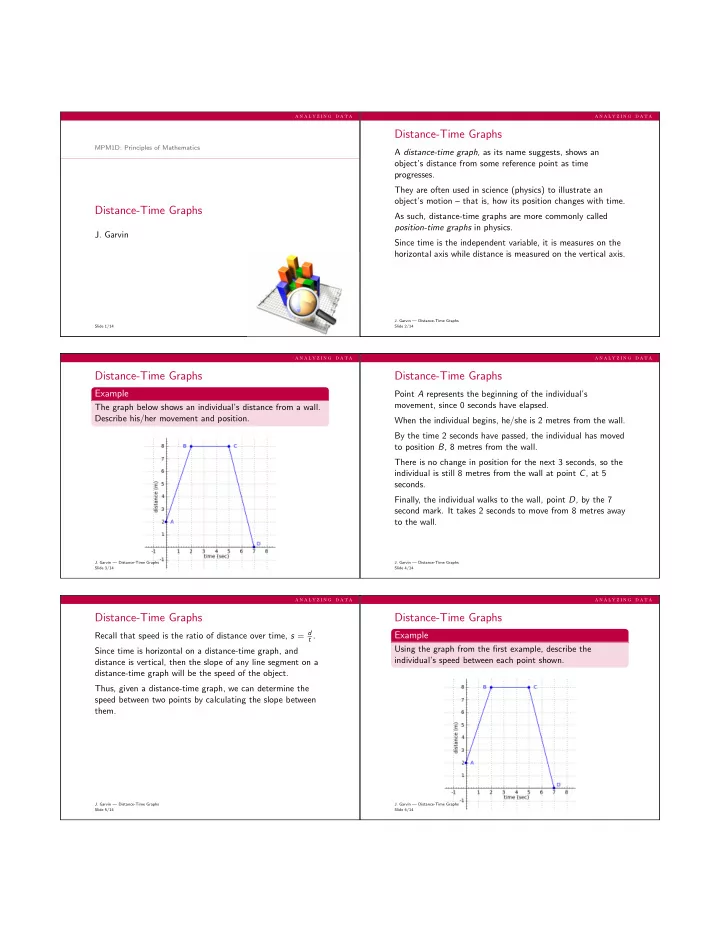

a n a l y z i n g d a t a a n a l y z i n g d a t a Distance-Time Graphs MPM1D: Principles of Mathematics A distance-time graph , as its name suggests, shows an object’s distance from some reference point as time progresses. They are often used in science (physics) to illustrate an object’s motion – that is, how its position changes with time. Distance-Time Graphs As such, distance-time graphs are more commonly called position-time graphs in physics. J. Garvin Since time is the independent variable, it is measures on the horizontal axis while distance is measured on the vertical axis. J. Garvin — Distance-Time Graphs Slide 1/14 Slide 2/14 a n a l y z i n g d a t a a n a l y z i n g d a t a Distance-Time Graphs Distance-Time Graphs Example Point A represents the beginning of the individual’s movement, since 0 seconds have elapsed. The graph below shows an individual’s distance from a wall. Describe his/her movement and position. When the individual begins, he/she is 2 metres from the wall. By the time 2 seconds have passed, the individual has moved to position B , 8 metres from the wall. There is no change in position for the next 3 seconds, so the individual is still 8 metres from the wall at point C , at 5 seconds. Finally, the individual walks to the wall, point D , by the 7 second mark. It takes 2 seconds to move from 8 metres away to the wall. J. Garvin — Distance-Time Graphs J. Garvin — Distance-Time Graphs Slide 3/14 Slide 4/14 a n a l y z i n g d a t a a n a l y z i n g d a t a Distance-Time Graphs Distance-Time Graphs Recall that speed is the ratio of distance over time, s = d Example t . Using the graph from the first example, describe the Since time is horizontal on a distance-time graph, and individual’s speed between each point shown. distance is vertical, then the slope of any line segment on a distance-time graph will be the speed of the object. Thus, given a distance-time graph, we can determine the speed between two points by calculating the slope between them. J. Garvin — Distance-Time Graphs J. Garvin — Distance-Time Graphs Slide 5/14 Slide 6/14
a n a l y z i n g d a t a a n a l y z i n g d a t a Distance-Time Graphs Distance-Time Graphs Example It takes 2 seconds to travel from point A to B , a change from 2 metres to 8 metres. Use the graph below to interpret an individual’s position from a wall, and his/her speed. The slope of this segment is m = 8 − 2 2 − 0 = 3. Therefore, the individual’s speed is 3 m/s. Since the segment from B to C is horizontal, it has a slope of zero. Therefore, for the 3 seconds between B and C , the individual is motionless. To travel the 8 metres from C to D takes 2 seconds. Let this speed be negative, since the distance from the wall is decreasing. Therefore, the speed of the individual from C to D is m = 8 − 0 7 − 5 = − 4 m/s. J. Garvin — Distance-Time Graphs J. Garvin — Distance-Time Graphs Slide 7/14 Slide 8/14 a n a l y z i n g d a t a a n a l y z i n g d a t a Distance-Time Graphs Distance-Time Graphs The individual starts 5 metres from the wall, and stays In the previous examples, all line segments were straight lines. motionless for 2 seconds. While this is convenient, it is not entirely accurate. Over the next 3 seconds, the individual moves from 5 metres It takes time to speed up or slow down, so most “real life” to 2 metres away from the wall. His/her speed is distance-time graphs will be represented with curves m = − 3 3 = − 1 m/s. connecting straighter segments. The individual is motionless between 5 and 6 seconds. If a curve is getting steeper, an object’s speed is increasing , From 6 to 8 seconds, the individual walks toward the wall at whereas if a curve is flattening out, its speed is decreasing . a speed of − 2 2 = − 1 m/s. J. Garvin — Distance-Time Graphs J. Garvin — Distance-Time Graphs Slide 9/14 Slide 10/14 a n a l y z i n g d a t a a n a l y z i n g d a t a Distance-Time Graphs Distance-Time Graphs Example Between points A and B , the curve changes from fairly steep to nearly flat. How does the speed of the object, whose position-time graph is shown, change with time? Thus, the speed of the object is decreasing from A to B . From B to C , the curve gets steeper, so the speed of the object is increasing from B to C . Since the line segment after point C is a straight line, this indicates a constant speed . Beyond point C , the speed of the object is neither increasing nor decreasing. J. Garvin — Distance-Time Graphs J. Garvin — Distance-Time Graphs Slide 11/14 Slide 12/14
a n a l y z i n g d a t a a n a l y z i n g d a t a Distance-Time Graphs Questions? Example Use the distance-time graph below to create a story of your own. J. Garvin — Distance-Time Graphs J. Garvin — Distance-Time Graphs Slide 13/14 Slide 14/14
Recommend
More recommend